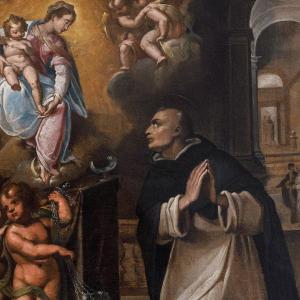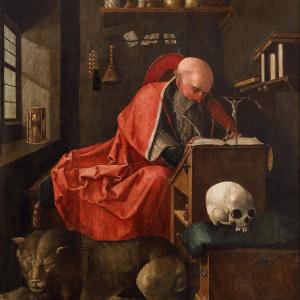BARTOLOMEO GENNARI, attrib. to
JESUS AND NICODEMUS
BARTOLOMEO GENNARI, attributed to
Cento 1594 – 1661 Bologna
Oil on canvas
121 x 103 cm / 47.6 x 40.6 inches; with frame 141 x 123 cm / 55.6 x 48.6 inches
The subject of this monumental painting has long been a matter of debate. When I acquired it in France many years ago, it bore the title Christ at Emmaus. However, I immediately rejected this interpretation, suggesting instead that the painting depicted the dialogue between Jesus and Caiaphas. This interpretation remained widely accepted for many years, until earlier this year, when I was unexpectedly contacted by experts from Sotheby’s.
A fragmentary version of my painting, attributed to Guercino himself, was put up for auction in London. As was often the case in Guercino's workshop, my painting turned out to be a repetition executed by his pupil Bartolomeo Gennari. The London painting depicted only a figure in Eastern attire (without Christ), and the Sotheby’s experts identified it as a representation of the high priest Annas, who had a dispute with Jesus.
This new perspective on the iconography prompted me to revisit the narrative of my painting and consult the New Testament as a source. After careful analysis, I concluded that the painting actually depicts a completely different episode—the dialogue between Jesus and Nicodemus.
The expressive figure of Nicodemus in the center of the composition, deeply reflecting on the words he has just heard, becomes the focal point of the painting. Thus, the artwork illustrates the moment when Christ, the Teacher of Israel, speaks of the necessity of being "born again." This episode, based on the Gospel of John (chapter 3), is rich in iconographic tradition that unites both Western and Eastern art.
It is important to note that traditional depictions of Christ Before Annas or Christ Before Caiaphas always portray Jesus with bound hands, in accordance with the Gospel text (John 18:12, 19–24). In my painting, however, Christ is free, clearly indicating a different narrative context.
This story once again demonstrates how the interconnectedness of works of art can shed light on the history and creative vision of the Old Masters.
PROVENANCE
France, private collection
RELATED LITERATURE
J. A. Calvi, Notizie della vita e delle opere del cavaliere Giovanni Francesco Barbieri il Guercino, Bologna 1808
La Scuola del Guercino, a cura di E. Negro, M. Pirondini e N. Roio, con prefazione di D. M. Stone, Modena 2004












































 Le Magazine de PROANTIC
Le Magazine de PROANTIC TRÉSORS Magazine
TRÉSORS Magazine Rivista Artiquariato
Rivista Artiquariato